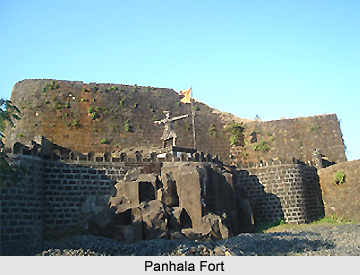 Siege of Panhala fort was undertaken by the joint forces of the Adil Shahi dynasty of Bijapur. Shivaji was proving to be an increasing threat to the Mughal and Adil Shahi forces. Thus, they sought to defeat him and for this purpose, they even allied together. According to the plans of the Mughals and Adil Shah, Adil Shah sent Siddi Jauhar in 1660 to attack Shivaji along his southern borders, preceding the expected major Mughal attack from the north. Siddi Jauhar ordered his army of forty thousand men to march north towards Kolhapur to confront and defeat Shivaji. This was a part of their alliance with the Mughal emperor Aurangzeb. For this purpose, he was successful in securing the support of local chieftains such as Jasvantrao Dalvi of Palavani and Suryarao Surve of Sringarpur to defeat Shivaji.
Siege of Panhala fort was undertaken by the joint forces of the Adil Shahi dynasty of Bijapur. Shivaji was proving to be an increasing threat to the Mughal and Adil Shahi forces. Thus, they sought to defeat him and for this purpose, they even allied together. According to the plans of the Mughals and Adil Shah, Adil Shah sent Siddi Jauhar in 1660 to attack Shivaji along his southern borders, preceding the expected major Mughal attack from the north. Siddi Jauhar ordered his army of forty thousand men to march north towards Kolhapur to confront and defeat Shivaji. This was a part of their alliance with the Mughal emperor Aurangzeb. For this purpose, he was successful in securing the support of local chieftains such as Jasvantrao Dalvi of Palavani and Suryarao Surve of Sringarpur to defeat Shivaji.
During the time of this plan of attack, Shivaji was camped at Panhala fort with eight thousand Marathas. Siddi Jauhar`s army besieged Panhala on 2nd of March 1660, cutting off supply routes to the fort. Helping with siege were Baji Ghorpade and Siddi Masud from the west, Sadat Khan and Bhai Khan from the north, Rustam Zaman and Bade Khan from the east, Siddi Jauhar and Fazal Khan from the south. The Commander of the Maratha forces, Netaji Palkar, was on a mission away from Panhala. He was at this time busy harassing and attacking Adil Shahi territory and was not able to come to the aid of Shivaji.
The fort of Panhala was a most formidable one. The army of the Adil Shahis was repeatedly repulsed by cannon fire and pelting of rocks. Siddi Jauhar approached Henry Revington, the British chief at the Rajapur port to seek long-range and more powerful cannons. Henry decided to help him in return for future favours, and began pounding Panhala fort. Despite this, the Marathas continued to defend Panhala, and succeeded in keeping Siddi Jauhar at bay. The Marathas, though without much success, also managed to raid the Adil Shahi camps a few times.
It was in one such raid that two from the Maratha side, Tryambak Bhaskar and Kondaji Farzand pretended to be allies of the British and Adil Shahi forces. They came down to the Adil Shahi camp and met Henry Revington and his associates. They managed to kill one British officer and injured Henry. They also managed to sabotage the canons and make them ineffective. Greatly angered at this incident, Jauhar made the siege even more intense. He undertook every possible measure to ensure that the siege around Panhala was unyielding, and personally ensured that no one in his army was complacent. He even braved the heavy monsoons and continued the siege even during heaviest downpours. When Netaji Palkar heard that the siege around Panhala had been further tightened, he returned from Bijapur and launched an attack on the Adil Shahi forces surrounding Panhala. However he was unsuccessful as his small force was pushed back by the much larger Adil Shahi army.
Following this, Shivaji decided to escape to a nearby fort, Vishalgad, in order to re group his soldiers. With this intention in mind, he sent misleading messages to Siddi Jauhar, indicating a willingness to negotiate. When the Adil Shahi forces received this message, they relaxed their vigilance. Taking advantage of this, Shivaji escaped from Panhala on a stormy night. Meanwhile, the soldier`s of Jauhar`s army claimed to have captured a small group of Marathas including Shivaji. On closer inspection it was realised that he was only a look alike named Shiva Kashid who was dressed like Shivaji. This was a mere diversion that had been created in order to facilitate the escape of the real Shivaji. However this realisation came too late as Shivaji had already fled to Vishalgad and thus the siege on the Panhala came to nothing in the end.



















